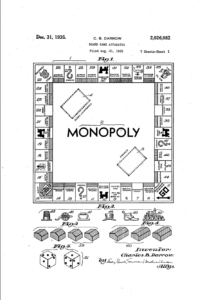I have seen a lot of people writing online that it is not possible to obtain a patent on a board game. That is simply not true. So in the interest of correcting this widespread misconception, I have compiled a collection of ten of the most interesting board game patents:
Number 10 – Monopoly
Monopoly is the board game so nice they patented it twice, or three times, at least. While you cannot obtain a patent on an invention that has already been patented, you can get a patent on  improvement to that invention which, in the case of Monopoly, happened more than once. In 1904, Elizabeth Magie Phillips patented The Landlord’s Game, which was a very early version of the board game Monopoly. Ms. Phillips’ patent expired in 1921, so she pursued and, in 1924 was awarded, a new patent on a new version of The Landlord’s Game.
improvement to that invention which, in the case of Monopoly, happened more than once. In 1904, Elizabeth Magie Phillips patented The Landlord’s Game, which was a very early version of the board game Monopoly. Ms. Phillips’ patent expired in 1921, so she pursued and, in 1924 was awarded, a new patent on a new version of The Landlord’s Game.
Ms. Phillips’ continued to hold the patent on The Landlord’s Game until 1935. She continued to publish the game through her publisher until she sold the rights in her game to Parker Brothers in 1935 for a mere $500. Parker Brothers had no intention of selling Ms. Phillips’ game, only purchasing the rights to avoid Ms. Phillips, or any other potential purchaser of her patent, from suing Parker Brothers for selling a similar game it was much more interested in promoting. That game is the board game we know today as Monopoly. Charles Darrow patented Monopoly in 1935. Mr. Darrow’s patent covers a board game with spaces servings as rentals subject to increase by the acquisition of an additional space or spaces of the same type. Within a year, Parker Brothers was selling 20,000 Monopoly games a week, leading to Mr. Darrow becoming the first board game designer millionaire in history.
Claim 1 of U.S. Patent No. 1,509,312 reads as follows:
1. A game-board, having corner-spaces, one constituting the starting-point, and a series of intervening spaces indicating different denominations, some of the spaces of the different series corresponding, and distinguished by coloring or other marking, so that the corresponding divisions on the four spaces may be readily recognized.





Recent Comments